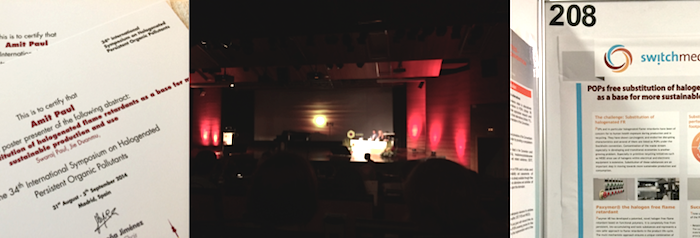Paxymer newsletter Sept 2014: Dioxin conference
The conference Dixon 2014, the 34th annual symposium on Dioxins and Dioxin identification, was filled with creative and interesting discussions. It is clear that new alternatives has to be put into use in the near future and this is agreed upon by scientists, NGOs, policy makers and industry alike. Paxymer was one of the invited SMEs, involved in the “Sustainable production and use” seminar.
In the opening plenary Prof. Joan Grimalt addressed the considerations and effects of DDT. Although banned in large parts of the world it is still used today as an insecticide to fight malaria in Africa. His point was simple, DDT does good in the fight against malaria and reduces the disease greatly however the effects of the people in the area are widespread from impaired nervous system development to asthma. He ended his lecture in a question: What negative secondary effects of an effective Dioxin are we willing to accept in order to take advantage of its primary functionality?
A discussion surrounding flame retardants regarding their functionality and whether they approve fire safety of products has been raging in the USA after the HBO documentary “Toxic hot seat” was released. The argument made by Prof. Arlene Blum and her team is that the fire standards used to evaluate flame retardant materials are designed in such a way that they provide very little, if any safety improvement. Instead there has been proof that in some cases these halogenated flame retardants further deteriorate the fire situation. They ask themselves similarly to Prof. Grimalt: what is then the point of flame retardants?
We at Paxymer see that there is a way to improve fire safety and eliminate Dioxins from materials at the same time. New fire standards evaluate smoke toxicity, dripping and heat release rate and will give a better idea of the effects of a certain material in a real fire scenario. The legislation for banning substances is however still slow and implementation of new alternatives require some motivation. Therefore an important part of achieving the pressure are market and public interest groups that focus on the balance between safety and function and are not invested in a certain technology.
The session “Sustainable production and use” ended with a discussion session on how to provide this motivation involving researchers, industry, NGOs and policy makers. The conclusions align well with our experience of successful substitution projects at Paxymer:
- promoting increased ownership of the issues by the OEMs and brand owners is efficient to achieve substitution of hazardous alternatives since they have the ultimate understanding of the products use and usability.
- scientists have a communication challenge where they will have to address policy makers and NGOs to a larger extent in order to achieve impact with their findings.
This is well aligned with how we at Paxymer work. Utilizing the latest research findings we aim to achieve sustainable substitution and providing the best possible functionality while focussing on fire safety primarily and fire standards secondarily.
/Amit Paul, Paxymer AB
Newsflash: New Paxymer webpage
We recently launched our new webpage as an initiative to stay connected and to provide the best service to our customers. Please drop by for a visit at Paxymer.se.
Dioxin 2014: ”Production and sustainable use” highlights
We have summarized some of the presentations held during the “Sustainable production and use” chaired by Dr Roland Weber and Frederic Gallo from Switch med below.
1) “How can we avoid the lock-in problem in the substitution of hazardous chemicals used in consumer products?”
Dr Martin Schringer represents a group called IPCP (the International panel on chemical pollution) they have studied the resistance to substitution and why substitution of hazardous alternatives take such a long time even when the legislation is in place. They found three main factors:
i) Implementation difficulties – increased cost or investments. Differing properties between hazardous and green solutions and finally continued production of hazardous alternatives in markets that have not implemented the bans are some important aspects of this inertia
ii) Incremental innovation – the tendency of the chemical industry to only incrementally change the banned substance, re-launching it as a substitution. This would very much be in line with Dr Huans findings on PFOS substitution in China (se below under 4).
iii) Lacking documentation of and supply of green alternatives. Information sharing and promotion of sustainable alternatives is an important part in facilitating substitution.
2) “Chemistry for any weather: per- and polyflourinated chemicals in textile products and ambient air.”
Manfred Santen of Greenpeace presented their initiative within the textile industry where they have a commitment from the 20 major producers of clothes to move away from fluorinated solutions before 2020. The work has had a major impact and was also used as an example for how transparency can improve the conditions and drive greening of an entire industry.
3) “Six classes: A new approach to reducing the use of harmful chemicals and preventing regrettable substitution.”
Arlene Blum and Simona Yi-Balan presented their latest work on Six classes of chemicals. This is a tool that they intend to launch for purchasers in order to help them in putting up relevant considerations and questions when looking into product design and development.
4) “Preliminary study on the environmental friendliness of PFOS substitutes for key applications in China.”
Dr Huang made a study of chinese PFOS substitution and also investigated the alternatives finding strong implications that PFOS alternatives that were introduced in connection with the European ban of PFOS in 2010 are connected with the same environmental an health concerns as the PFOS.


Comments are closed.